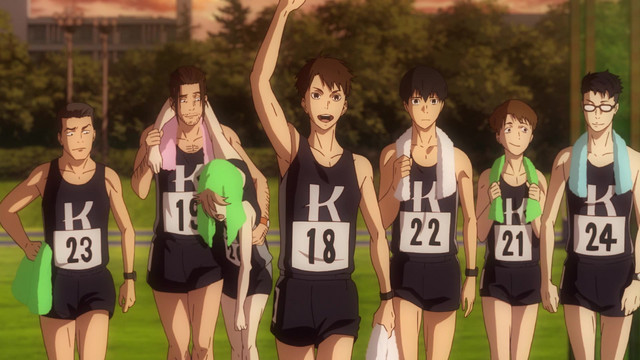
A Race to the Top
- Episodes : 23
- Genre : Comedy, Sports, Drama
- Airing Date : October 2018 to March 2019
- Producers : Production I.G
Contains Spoilers
Kaze ga Tsuyoku Fuiteiru (Run with the Wind) Introduction and Story
While the genre is an acquired taste, sports anime are quite accessible regardless of whether the central activity holds any personal interest. A few shows pay more attention to the game itself, but most employ the sport as a tool to foster endearing relationships and promote character development. Although boxing is not for everyone, the majority of people can relate to a timid character seeking to break out of his shell. In a great sports anime, the sport tends to be secondary. Run with the Wind serves as a perfect example of this point.
As implied by the title, Kaze ga Tsuyoku Fuiteiru centers around a University's relay team trying to qualify for the Hakone Ekiden marathon. A former runner forced to retire due to an injury, Haiji Kiyose has spent the last four years secretly persuading students to join his dorm in order to build a team capable of going the distance. The final piece of the puzzle arrives in the form of Kakeru Kurahara, a brilliant albeit unsocial runner who turns his back on the sport after an episode in high school. It will take some convincing and a whole lot of training but Haiji plans to transform nine strangers into a Hakone relay team!

1. A Group Effort
Putting aside shows revolving around solo sports, the genre's entries typically focus on the main character's interactions with the club's members. While Shohoku High's basketball team are all well-developed, Slam Dunk remains Hanamichi Sakuragi's story. Arguably the only proper runner on the team, Kakeru technically qualifies as Run with the Wind's protagonist. That being said, the anime essentially has an ensemble cast. Hakone is split into ten sections with a different runner handling each portion. A team must consist of ten members to participate, therefore everyone is as equally important to the cause as Kakeru. Run with the Wind explores all ten characters.
2. The Journey & the Destination
As the old saying goes, it is the journey that matters and not the destination. Ideally, an enthralling journey culminates in an exciting climax that serves up a satisfying conclusion to the plot and characters. Run with the Wind is the full package! Every single character matures throughout the course of the series, while the final stretch of episodes offers a sense of conclusiveness too often absent in anime. As the original manga ended a long time ago, the adaptation was free to tell a complete story rather than drag things out in hope of a sequel. By the end of the series, Run with the Wind has guided audiences on an emotionally exhaustive and fulfilling adventure with a group of flawed but likable friends.
3. Slice of Life
Run with the Wind is listed under sports, comedy, and drama. The anime definitely produces enough laughs, tears, and heart-pounding sprints to convince as a member of each genre. That being said, slice of life fans should consider trying out Production I.G.’s series. Haiji may be grooming the guys to participate at Hakone, but the majority of the episodes center around the team’s everyday lives and training. Winning Hakone is not the point. Run with the Wind is preoccupied with exploring a group of wildly different university students as they attempt to attain confidence in themselves prior to embarking towards adulthood. Run with the Wind amounts to more than a sports anime.
1. A Lethargic Start
Lasting for 23 episodes, Run with the Wind is longer than most. The first cour primarily deals with Haiji’s repeated attempts to convince the rest of the guys, who are understandably dismissive of their chances of qualifying for Hakone, to form a team. Due to his past, Kakeru puts on a defensive front whenever interacting with the rest of the cast. Combined with the team’s resistance to Haiji’s plan, a fair number of the early episodes amount to endless bickering between the guys. Although Run with the Wind does not exactly stumble out of the gate, the anime saves its energy for the final stretch. This slower pacing suits such a character-driven narrative, even if the show’s brilliance only begins to truly reverberate during the second cour.
Final Thoughts

Run with the Wind ranks among the greatest sports anime in recent memory and also offers something to keep those uninterested in the genre coming back for more. Production I.G. deserves praise for splendidly adapting Miura Shion and Sorata Unno’s 2007 manga into such a beautiful and warm anime.
Did you agree with our review? Is Run with the Wind worth watching? Please let us know in the comments below!




